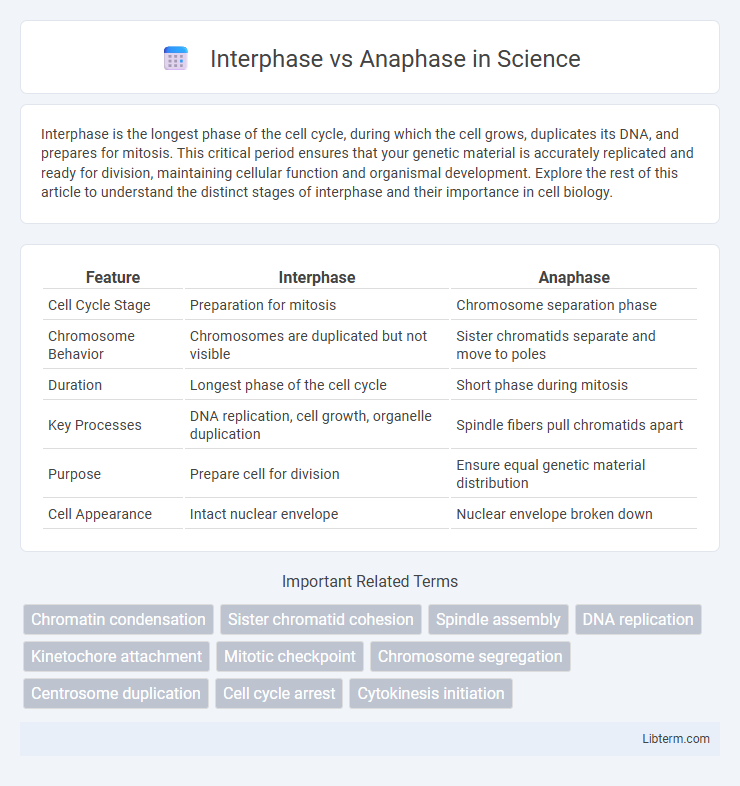Interphase is the longest phase of the cell cycle, during which the cell grows, duplicates its DNA, and prepares for mitosis. This critical period ensures that your genetic material is accurately replicated and ready for division, maintaining cellular function and organismal development. Explore the rest of this article to understand the distinct stages of interphase and their importance in cell biology.
Table of Comparison
| Feature | Interphase | Anaphase |
|---|---|---|
| Cell Cycle Stage | Preparation for mitosis | Chromosome separation phase |
| Chromosome Behavior | Chromosomes are duplicated but not visible | Sister chromatids separate and move to poles |
| Duration | Longest phase of the cell cycle | Short phase during mitosis |
| Key Processes | DNA replication, cell growth, organelle duplication | Spindle fibers pull chromatids apart |
| Purpose | Prepare cell for division | Ensure equal genetic material distribution |
| Cell Appearance | Intact nuclear envelope | Nuclear envelope broken down |
Understanding Cell Cycle Phases
Interphase is the longest phase of the cell cycle, during which the cell grows, replicates its DNA, and prepares for mitosis, ensuring accurate genetic material duplication. Anaphase follows metaphase in mitosis, characterized by the separation of sister chromatids towards opposite poles, driven by the shortening of spindle fibers. Understanding these phases highlights how interphase sets the stage for cell division while anaphase executes the critical step of chromosome segregation.
What is Interphase?
Interphase is the longest phase of the cell cycle during which the cell prepares for mitosis by growing and replicating its DNA. It consists of three stages: G1 (cell growth), S (DNA synthesis), and G2 (preparation for mitosis). This phase ensures that the cell has the necessary components and genetic material for successful division in subsequent stages like anaphase.
Key Events During Interphase
Interphase involves critical processes such as DNA replication, centrosome duplication, and cell growth, preparing the cell for division. During this phase, the cell synthesizes proteins and organelles while ensuring the genetic material is accurately copied for mitosis. Unlike anaphase, where sister chromatids separate, interphase primarily focuses on cellular preparation and genome integrity maintenance.
Introduction to Anaphase
Anaphase is a critical stage of mitosis where sister chromatids separate and move toward opposite poles of the cell, ensuring equal genetic distribution. This phase follows metaphase and is characterized by the shortening of spindle fibers attached to kinetochores. The mechanical forces driving chromatid separation are essential for accurate chromosome segregation and cell division fidelity.
Major Processes in Anaphase
Anaphase is characterized by the separation of sister chromatids, driven by the shortening of spindle microtubules attached to kinetochores. This process ensures that each daughter cell receives an identical set of chromosomes, a critical step for genetic stability. The major events include the breakdown of cohesin proteins, which hold chromatids together, and the movement of chromatids toward opposite spindle poles.
Structural Differences Between Interphase and Anaphase
Interphase is characterized by a well-defined nucleus with decondensed chromatin allowing DNA replication, whereas anaphase features highly condensed chromatids actively separating towards opposite poles. During interphase, the nuclear envelope remains intact, maintaining compartmentalization, but in anaphase, the nuclear envelope has disintegrated to enable chromatid movement. The spindle fibers, absent in interphase, form a prominent mitotic spindle in anaphase essential for chromatid segregation.
Molecular Changes: Interphase vs Anaphase
During interphase, cells undergo DNA replication and chromatin remodeling facilitated by cyclin-dependent kinases, resulting in duplicated chromosomes poised for division. In contrast, anaphase is marked by the proteolytic cleavage of cohesin proteins by separase, enabling sister chromatids to segregate toward opposite spindle poles. These molecular changes ensure accurate chromosome duplication during interphase and precise chromatid separation during anaphase, critical for genomic stability.
Significance of Chromosome Behavior in Both Phases
During interphase, chromosomes replicate and prepare for cell division, ensuring genetic material is accurately copied for daughter cells. In anaphase, sister chromatids separate and move toward opposite poles, guaranteeing equal distribution of chromosomes. This precise chromosome behavior in both phases is critical for maintaining genetic stability and preventing mutations.
Biological Importance of Interphase and Anaphase
Interphase is crucial for cell growth, DNA replication, and preparation for mitosis, ensuring genetic material is accurately duplicated. Anaphase is vital for the equal segregation of sister chromatids to opposite poles, which maintains genetic stability during cell division. Proper functioning of both phases guarantees successful cellular reproduction and organismal development.
Summary: Interphase and Anaphase Compared
Interphase is the cell cycle phase where DNA replication and cellular growth occur, preparing the cell for division, while Anaphase is a stage of mitosis characterized by the separation of sister chromatids to opposite poles. Key molecular events in Interphase include DNA synthesis during the S phase and centrosome duplication, contrasting with Anaphase's kinetochore microtubule shortening that drives chromatid migration. The functional distinction is clear: Interphase focuses on cell preparation and genome duplication, whereas Anaphase executes physical chromosome segregation, ensuring accurate genetic distribution to daughter cells.
Interphase Infographic

 libterm.com
libterm.com